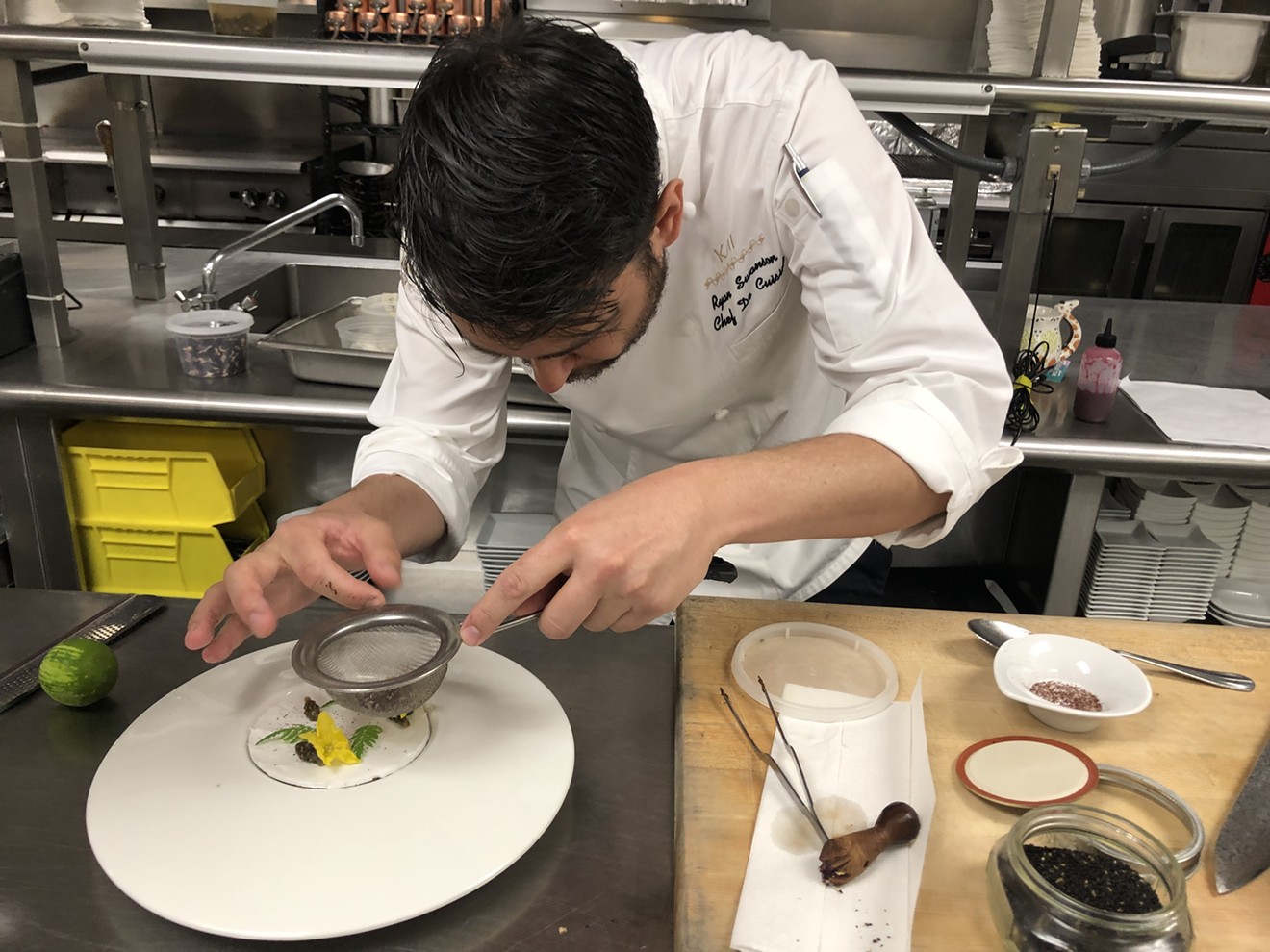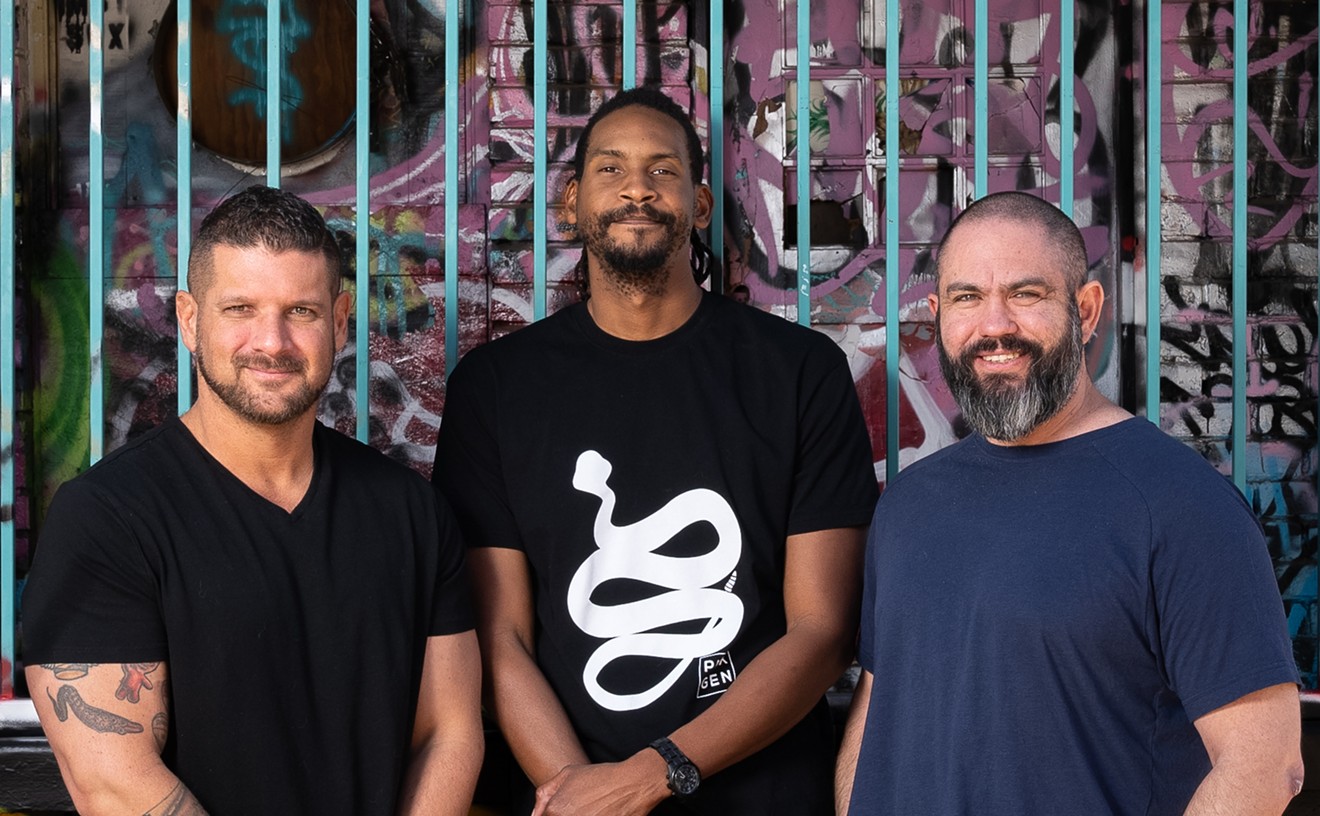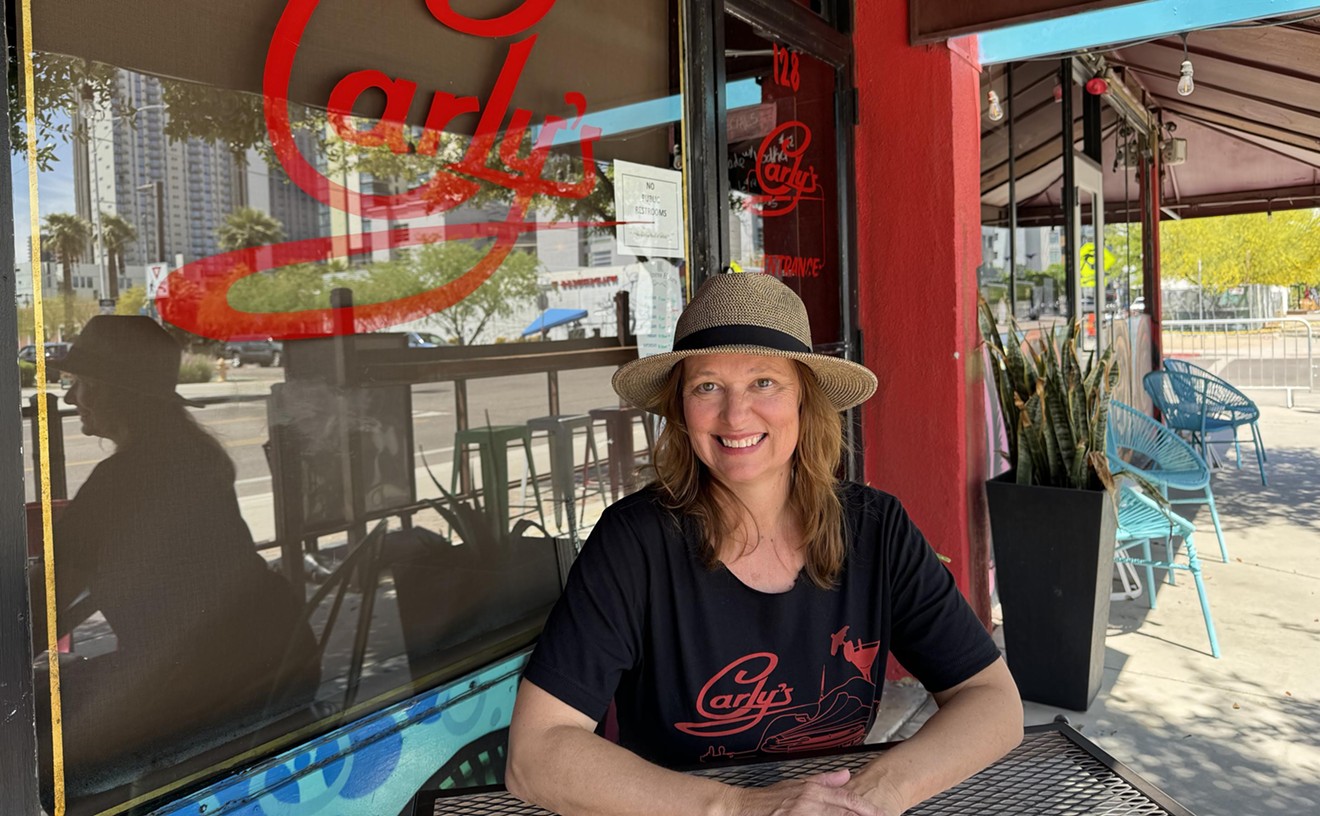Welcome to Sonoran Arcana, a column seeking to probe the margins of Arizona cuisine and define a more specific, novel cuisine that has emerged in America's great Sonoran Desert, New Arizonan. Here, we will venture into the arid wilds and culinary unknown to spotlight the chefs and foragers, the millers and brewers, the miso masters and palo verde pod pickers who are pioneering New Arizonan cuisine, or simply rocking out the food of Arizona. So throw open the doors to your mind and enjoy.
Ryan Swanson lost three hours of sleep last night. Usually, he says, he loses closer to five hours the night before he begins testing a new dish. “You’re thinking is this gonna work, is that gonna work?” he says, recalling the previous night's stressors. Swanson, the head chef at Kai Restaurant, has plenty to think about, as his plates often weave more than a dozen ingredients, many specific to the Sonoran Desert.
And so on short sleep, Swanson — the only of Kai’s eight cooks now in the kitchen, the only Kai employee in the restaurant at all — puts down his mug and gets to work creating his latest dish.
It’s just after noon on a Saturday, the second day Swanson has been developing a new dessert. His process often takes two to five weeks of tinkering, leaving time for every creative possibility to emerge. If at the end of this span a single aspect is out of place, he scraps the dish completely.
“Let’s say we charge $20 for this dessert dish,” he says. “I want to give every cent of that $20.”
Swanson has just returned from Kai’s annual summer break. Now, entering a new season where the menu will change more than any in recent memory, Swanson is concepting a dessert that can provide an antidote to the late-summer heat.
The dessert? A Sonoran riff on a classic: key lime pie.
“I kind of wanted to do a key lime pie, but with cactus,” he says. “Instead of key lime, I wanted to do nopales.”
The day before — his first day of work on the dish — Swanson made “eight to 10” small pies, all different. He kept only three. One sits on a ceramic plate, its center glistening a pale green from cactus paddles. The plate sits under four sleek-hooded copper lights, where, now Swanson reaches for liquid nitrogen.
This being Kai, pie is just the beginning.
Since opening in 2002, Kai has been a leader in writing the next chapter of Arizona food. Swanson and the head chefs before him have devised artful menus that transform, spotlight, and elevate Sonoran ingredients. Many come from the Gila River Indian Community, which owns the celebrated but recently unsung restaurant. These ingredients are then creatively, thoughtfully, elegantly married with global techniques and traditions. Like the rest of the Kai menu — buffalo steak with saguaro blossom syrup, foie gras with puffed amaranth — Swanson’s key lime pie will be a creation new to the world.
Following this summer's hiatus, Swanson wants to evolve more than usual. “This season, we’re looking to change the menu progressively through the season,” he says. “So when vegetables come in or ingredients grow, we’ll move to those.”
Same creative spirit. New dishes replacing old staples. Maybe even the buffalo steak.
Thinking, aiming at a copper saucepan, Swanson hoists a tank of liquid nitrogen. “I’m trying to find a way to include as much cactus as I possibly can,” he said a moment before, as he lugged the tank from his neatly laid work station down the table.
He pours. Liquid nitrogen collects in the pot. Cold fog plumes over the metal table, curls down its sides. Swanson trains his eyes on the pot, all focus focus focus, before lifting and carrying the pot back to his work station — a cutting board soon to see a motley roster of Sonoran spices, flowers, dusts, pickles ...
At his station, Swanson produces a plastic bottle of prickly pear gastrique: fuchsia liquid mixed with lime juice, lime zest, and elderflower vinegar. He squeezes single drops into roiling liquid nitrogen. They freeze instantly, creating, Swanson says, “dippin’ dots.”
So far, prickly pear is the second cactus in this "key lime pie." So far, the pie baked the night before remains unadorned, shining the thin spectral green of a giant sunset at the end of an especially hot Sonoran summer day, the whole pie just the size of a coaster.
“I’m working on a name,” Swanson says. “There’s usually eight bullet points I go through when I’m making a dish. That’s not even everything; those are the main things.” As Swanson reaches for a plate so he can begin assembly, eight numbered points face him, scrawled on paper.
1. What’s the theme?
2. What’s the story?
“If I had to give this a story, I’d probably dedicate it to Velvet Button,” Swanson says. “She foraged all these ingredients or they grew it at Ramona Farms. This is kind of a tribute to Velvet for all her hard work.” One of Kai’s primary providers, Ramona Farms grows varieties of indigenous corn, tepary beans, heritage wheat, and other crops on scattered plots in the Gila River Indian Community. Button, a teacher, cook, gatherer, and free spirit, is part of the farm’s second generation.
3. What’s the flavor/season?
4. What’s the idea?
The idea is to channel key lime pie's flashbang tang using desert plants, mostly cactus. “Nopales is the best cactus for the center of this pie, because it’s light but it kind of has that savory tone, and that will add tartness,” Swanson says. Nopales have been blended into the pie’s center. He will also use chips cut from nopales, each the size of a flat thimble, each with, he says, "a salsa quality.” When complete, this freewheeling pie riff should “look elegant and beautiful and somewhat represent the terrain that [Button] goes out and works in.”
5. What’s the plate?
The plate is a yawning saucer sloping up to a raised center: a circular hollow. Now, Swanson sets the pie in the hollow. Atop the pie he adds a flat circle of meringue — perfectly cut to fit the hollow, obscuring the pie beneath.
6. How to serve it?
7. Does it suck or does it work?
8. What’s the name?
As Swanson moves to the step after placing the meringue, his dish remains nameless. Quickly, he zests a lime. Like sound, the fruit’s heady perfume instantly fills the kitchen air.
From here, assembly is swift. In a flurry of spooning and tweezing, ingredients appear atop the white meringue. Swanson adds citrus lace, small green growths from orange trees. He perches two neon-yellow cucumber flowers. “Cucumber and I think lime and cactus, they just go together," he says.
Carefully, he places pickled cholla buds. He and his team recently foraged these with some Gila River Indian Community members, who scrubbed the spines off with a stick and screen. Usually used in savory dishes, Swanson notes that the buds can layer a dessert with acid and earthiness.
Shifting gears, Swanson grinds desert willow (“like tea”) and wild sumac (astringent and like lemonade berries) in a mortar and pestle, then sieves their fine dust onto the meringue, speckling it like some songbird's egg. More lime zest follows. Some nopales powder, too. And then a sprinkling of coal-black barrel cactus seeds, partly for visual texture. At last, Swanson adds the final kitchen touch: an oblique slash of the prickly pear “dippin’ dots,” still frozen like tiny icebergs.
Moving to the stove, Swanson quickly heats up a saucepan of the purple gastrique, then brings it and the plated pie out to the dining room.
“I’m thinking about flavor all the time,” he says, “but what I’m also thinking about what somebody is looking at when you get something put in front of you.”
In the Kai dining room, on a white tablecloth by a window, the plate looks like a yellow-green garden grown in snow. Swanson hopes that the prickly pear gastrique, poured hot table-side, will melt through the meringue and reveal the pie underneath. Slowly, the copper saucepan high, he tilts the rim.
Drops of purple splash into the desert garden.
Liquid gathers atop the meringue. The pool widens. But no melting.
Swanson gives a quick laugh. “We’ll just have to crack it,” he says. He whacks the meringue with a chilled spoon, caving the surface. With a continuous flute wandering and soaring from the speakers, Swanson tastes the first realized version of his new dessert.
It is light, bright, and summery — built for heat. There is a deeply earthy, vegetal quality, but in the airiest way possible. Each bite is different: some more citrusy, some duskier, some with the coolness of “dippin’ dots.” The anchor for everything is the crust, sculpted from Ramona Farms pinole (ground wheat and corn), packed with a roasted, primal intensity.
After a few ruminative bites, Swanson nods. “I think the flavor is fantastic," he says. "If anything, it’s how is this going to be presented to the guest?”
He sets down his chilled spoon. “I’ll run it by the guys tonight,” he says, a smile slipping over his poker face. “I’ll probably spend a few weeks on this dish. Maybe two or three weeks... I’m actually pretty happy with it. It’s very rare that I’m that happy with a dish the first time.”
Kai Restaurant. 5594 Wild Horse Pass Boulevard; 602-225-0100.
Hours: 5:30 to 9 p.m., Tuesday to Thursday; 5:30 to 9:30 p.m., Friday and Saturday
[
{
"name": "Air - MediumRectangle - Inline Content - Mobile Display Size",
"component": "18478561",
"insertPoint": "2",
"requiredCountToDisplay": "2"
},{
"name": "Editor Picks",
"component": "16759093",
"insertPoint": "4",
"requiredCountToDisplay": "1"
},{
"name": "Inline Links",
"component": "17980324",
"insertPoint": "8th",
"startingPoint": 8,
"requiredCountToDisplay": "7",
"maxInsertions": 25
},{
"name": "Air - MediumRectangle - Combo - Inline Content",
"component": "16759092",
"insertPoint": "8th",
"startingPoint": 8,
"requiredCountToDisplay": "7",
"maxInsertions": 25
},{
"name": "Inline Links",
"component": "17980324",
"insertPoint": "8th",
"startingPoint": 12,
"requiredCountToDisplay": "11",
"maxInsertions": 24
},{
"name": "Air - Leaderboard Tower - Combo - Inline Content",
"component": "16759094",
"insertPoint": "8th",
"startingPoint": 12,
"requiredCountToDisplay": "11",
"maxInsertions": 24
}
]

















